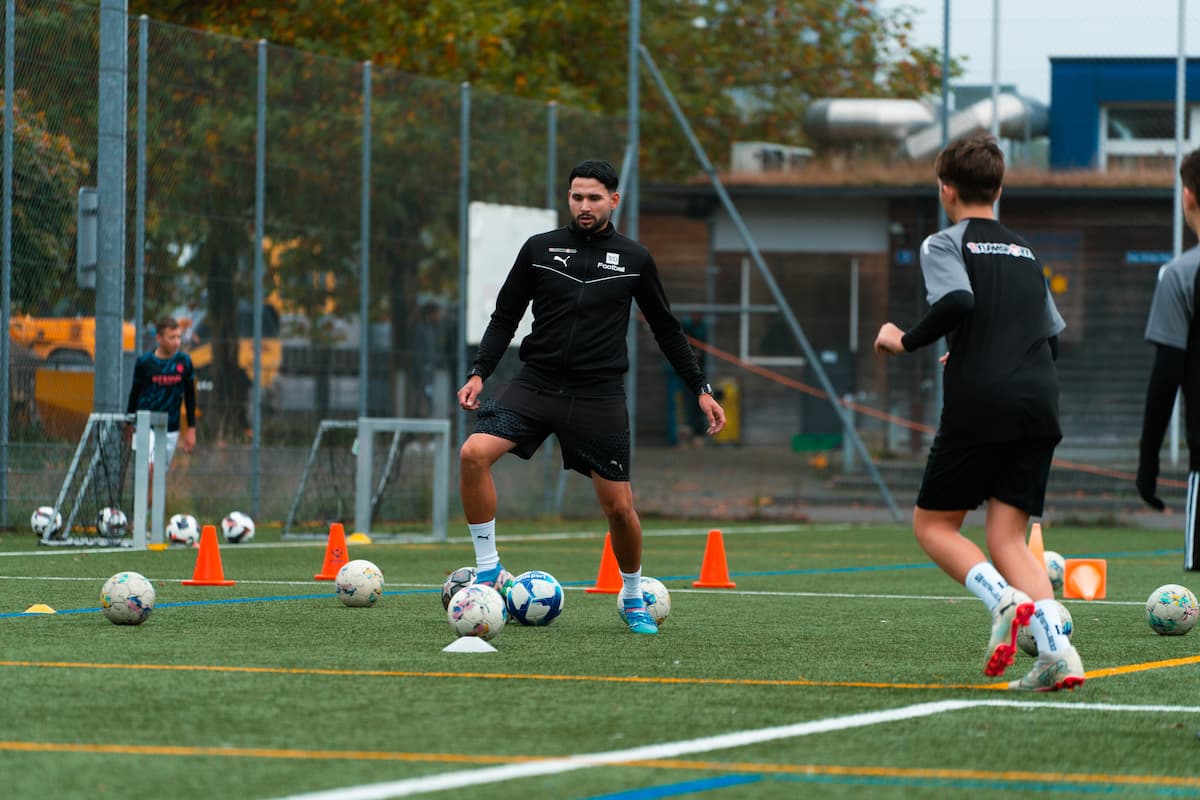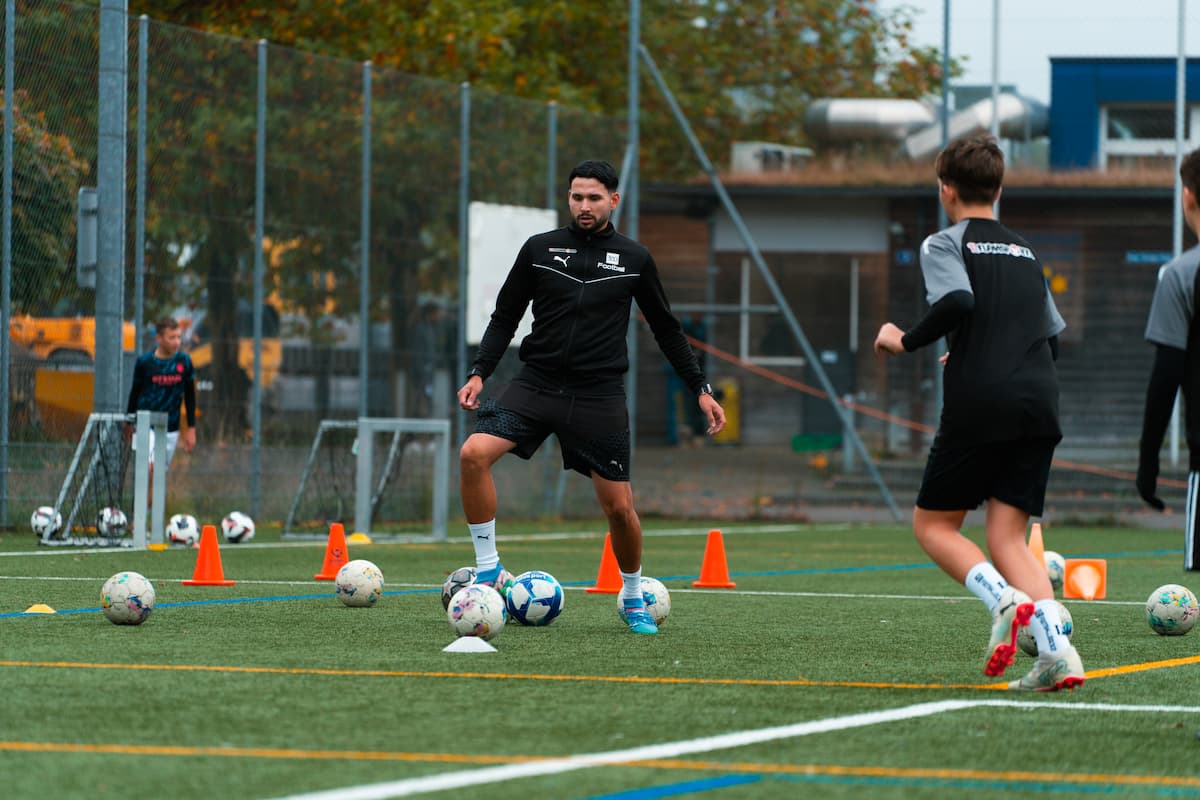Building up the game in football can be very challenging against a well-organized opponent. Especially in top-level football, the spaces near the ball are made very narrow with the help of high running intensity and clear defensive strategies. That's why long passing relays or winning 1-on-1 situations are often needed just to gain some space. This is also why strategies in positional play have emerged in recent years to make it easier to build up the game and also pose problems for well-organized “defensive bulwarks”.
One solution to the positional play of the build-up game is the dynamic interpretation of positions - sixes that tip over between the central defenders, wingers or full-backs who break away from the wing into the half-space or strikers who move into the gaps behind the opposing midfield line.
The central role in the game structure
Only one position in the build-up to the game remains largely static – the position of the central defender. The central defender is almost always the starting point of the build-up play. From the central, withdrawn position, the defenders initiate the build-up game. The central defenders give the first impulses, determine the tempo, decide in which direction the game is directed and thus play a significant role in shaping their own team's build-up game.
For this reason, as a central defender in modern football it is not enough to just be a defensive specialist. Not the number 10, but the central defender is the real playmaker in modern football. Accordingly, the requirements profile of the central defender has expanded enormously in recent years.
Specialist in long-range passes
An essential skill that you should have as a central defender these days is precise passing. Because together with the sixes, you are usually the player who plays the most passes within 90 minutes. This is mainly due to your central, withdrawn positioning in the build-up to the game. This position in the build-up game makes you the starting point for almost every build-up game and an essential passing point for back passes or an intermediate station for shifting the game. This means you will make a variety of passes within a game.
You play some of these passes as a central defender over medium and long distances, as your team makes the field particularly wide and deep in the build-up game and you act somewhat withdrawn as a central defender. This leads to large distances from your teammates and the other parts of the team and consequently to longer passing routes.
The passing distances become very long, especially if you outplay teammates or even parts of the team. For example, if you want to shift the game to the full-back who is far from the ball, you can simply outplay the second central defender if the risk of a bad pass is not too great. The "saved" intermediate station accelerates the shift in play and creates more space on the side being played - provided you play the ball with sufficient sharpness and precision.

However, since the passing path from you to the full-back on the side far from the ball is very long, the impact force of an inside kick is not sufficient for the pass - at least if the ball is supposed to reach your teammate at speed, which means that the shift in play leads to an increase in space.
To ensure that the ball reaches the full-back sharp enough, you play the ball with your inside instep. With this striking technique you can play flat, precise and at the same time powerful passes.
Therefore, train your inside instep shot as a central defender regularly, for example with this exercise:
Diagonal flying balls
You can use the inside kick not only for flat passes, but also excellently for high passes - especially for diagonal flying balls.
These balls are particularly useful when the opponent is standing very high and there is a lot of space at the back of the opposing back four. Space that you as a central defender can use very well with an inside shot.

-
... you play the balls with backspin. This slows down the ball slightly after the first contact with the ground and prevents it from jumping too far away or directly out of bounds. Hit the ball below center to play it with backspin.
- ...you play the ball without spin. For crosses and shots with the inside instep, it can definitely make sense to pass the ball with a “cut”. This allows you, for example, to play around an opponent or turn the cross away from the goalkeeper. With flying balls, however, Effet isn't really useful because the pass receiver has a harder time assessing the trajectory and the ball is harder to process. Don't swing your back leg and hit the ball in the middle and not outside in order to play it without spin.
- ...you pay attention to the surface of the pitch before the game starts - are you playing on grass or artificial turf? Is the lawn freshly mown or already a few centimeters high? Is the pitch dry or wet? Above all, how does the ball behave on this surface?
-
... you don't play the ball higher than necessary. Your flying ball should go over the opponent's chain but should not be played unnecessarily in a particularly high arc. This means that the ball travels unnecessarily for a long time and the opponent has more time to move backwards. You can control the trajectory of the ball using your upper body position. Go back more and hit the ball lower if you want it to fly higher . But if you want the ball to fly a little flatter, you can hit it a little higher up but still below the middle.
- ...you train these regularly. Training the flying ball is most effective if you present the ball once and then play it, because you will rarely play stationary balls in the game. In order for the training to be really close to the game and therefore effective, you should always play the ball while it is in motion.
- ... play the ball as gently as possible. If you prepare a flying ball with 3 or 4 contacts and keep looking into the depths, your opponent will quickly recognize your intentions. This gives the opposing chain enough time to move backwards and intercept the flying ball. Therefore, orient yourself before the first contact and “scan” the passing stations in depth. By taking the ball with you, you prepare the flying ball in the best possible way so that you can play the ball onto the wing with the second contact.
So that you need as little time as possible to play a flying ball or another pass, you should work on your pre-orientation and your first contact. These exercises will help you:
Dribbling as a central defender
After the focus so far has been primarily on the passing game and the first contact of the central defender, we will now look at the requirements for the dribbling of a central defender.
As a central defender and last man, you will rarely be looking for 1-on-1 situations. However, as a central defender, you can surprise your opponent at the right time and let them run into space.
For example, if your opponent runs at you in an arc to block the passing path to the full-back near the ball, you can use a passing feint. To do this, turn the front of your body towards the full-back when you receive the ball and indicate a pass to the outside defender by swinging your foot out. Your opponent will move further into the passing path between you and the full-back in order to intercept the possible pass. But instead of playing the pass, you take the ball forward with an explosive dash.
Every now and then, as a central defender, you involuntarily have to demonstrate your ability to handle the ball. For example, if you find yourself in a game situation in which you have an attacker behind you, you have to act with your back to the direction of play and no teammate can pass the ball - neither the goalkeeper nor a field player.
In this case, as a central defender you have to stay calm. Guide the ball with the foot that is far from your opponent and shield it well from your opponent. If you keep your body between the ball and the opponent while dribbling, he will have little chance of winning the ball.
After a few seconds, there may be another pass point or an opportunity to break away from the opponent. If necessary, it is also a legitimate solution to clear the ball out of bounds if you cannot free yourself from the situation.
But regardless of how such a pressure situation develops as a central defender, it is important to keep a cool head and not become restless - even if losing the ball in this position can often be dangerous. So that you don't let such situations unsettle you, it's helpful to work on your mental attitude so that you can perform freely even under competitive conditions.
You can find out how you can become mentally strong and master every situation with confidence here:
outlook
In this blog post you learned how to successfully build up play as a central defender and how to act confidently in pressure situations. In the second part on the topic of central defenders you will find out more about the defensive play of this position. You will get helpful tips to...
- ...to take your opponents out of the game through clever positional play.
- ...to take every ball from your opponents through robust and clever duel behavior.
- ...to perfect your heading game and prevail in duels in the air.
About the author:
Luis Österlein (Twitter: LOsterlein ) is a game analyst for the U23 team at FC Bayern Munich and a freelance author. In close collaboration with 360Football, he writes specific blog posts that support players in their football development support.


